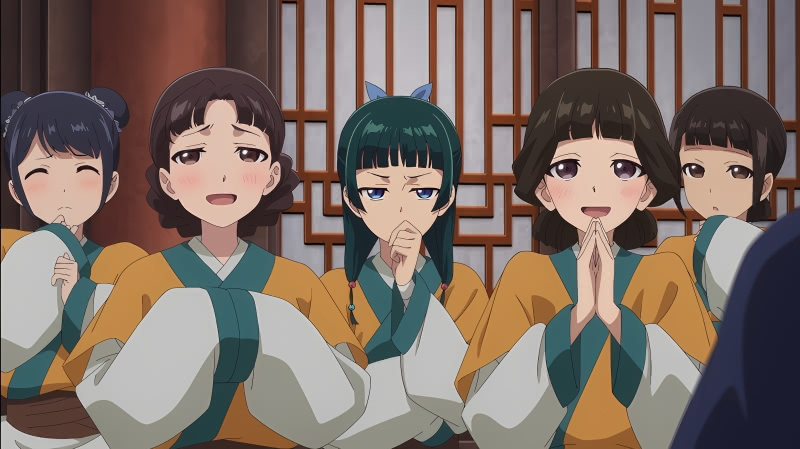The Apothecary Diaries is a Japanese light novel series that has been adapted into an anime. The anime series began airing on October 22, 2023, and will run through the March 2024. The series is very good through six episodes and I dare say that it would be on pace for a high (if not top) placement in my upcoming 2023 anime of the year article but for the fact that it ends in 2024 and thus will be part of my 2024 anime review article.
But this article is not a review of the first quarter of The Apothecary Diaries anime series. It is a discussion of hair color in The Apothecary Diaries series from the world’s leading 2D person hair color anthropology journal (probably).
(See my full collection of posts on hair color in Japanese anime, manga, novels, and games.)
In my first hair color study article, I explained that in understanding how to interpret unusual anime hair colors, one must first grasp the world in which the anime takes place. For example, it is more likely that a show with a fantasy setting or an element of magic intends for unnatural hair colors to be understood literally than does a show with a down-to-Earth real-world setting. These principles are not absolute – see e.g., my study of hair color in the down-to-earth My Senpai is Annoying – but they provide a good starting point.
The Apothecary Diaries, like one of my favorite 2022 anime series, Raven of the Inner Palace, has a fictional setting inspired by olden China (see my companion piece on hair color in Raven of the Inner Palace). The protagonist, Maomao, is the teenage daughter of an apothecary and an apothecary herself. One day while she is out running an errand, she is kidnapped and sold to the imperial palace where she works as a servant. Her attempts to keep a low profile and work her two-year term without incident are foiled when she tries to secretly leave a tip to save the children of two of the Emperor’s concubines. She fails at the “secretly” aspect and becomes a lady-in-waiting and poison tester who is conscripted into moonlighting as an amateur detective.
While The Apothecary Diaries has a fictional history-inspired setting, the series (through six episodes, at least) contains no magic. In fact, it features story lines wherein Maomao establishes that something people think is magic has a non-magical explanation. That is, it is by all appearances a show featuring ordinary people with Ming-era Chinese mores in a fictional setting inspired by Chinese history.
Most characters in The Apothecary Diaries have black, brown, or gray hair. Black and gray are to be expected from the China-inspired setting. While various shades of brown hair are not common in China, brown hair where black hair is expected can often be attributed to a small aesthetic choice outside of cases where the brown hair is specifically commented upon – see my studies of hair color in Oregairu, Ippon! Again, and The Girl I Like Forgot Her Glasses for examples. However, some characters have unusual hair colors that cannot so easily be written off. Chief among them is our green-haired protagonist, Maomao:
In the case of My Senpai is Annoying, a romantic comedy set in contemporary Japan, I wrote about being surprised to learn that the diminutive green-haired heroine actually had naturally green hair. Does Maomao have naturally green hair? I am not so sure.
As the series progresses, one will notice that the dramatic hair colors seem to be reserved for certain key characters. The second most significant character after Maomao, the eunuch Jinshi, has purple hair. The Emperor’s four principal concubines also have distinctive hair colors. Gyokuyō, whom Maomao works for as a lady-in-waiting, has pinkish hair.
In context, I interpreted the instances of unnatural hair colors as being driven by aesthetic considerations. That is, Maomao and Jinishi do not literally have green and purple hair. Instead, they are designed that way in order to highlight that they are significant characters.
I was inspired to write this article when I came across a note on hair color in the series by kViN of Sakuga Blog, a must-read site for long-form writing about animation in and production of Japanese anime. I quote the pertinent passage below:
The design sensibilities behind the series were never all that realistic, as is obvious by certain choices of hair colors…
This note is actually about the underlying light novel series, which uses the same hair colors in its illustrations as does the anime. I am aware of some cases wherein the anime deviates from the source material. For example, I covered the case of Kaori Orimoto having black hair in the Oregairu light novels but brown hair in the anime series. But in the case of The Apothecary Diaries, hair color is consistent.
I am not familiar with the Apothecary Diary novels, but considering this passage made me think of an alternative hair color interpretation here. I stand by my view that unusual hair colors are used to signify important characters in the series. With that being said, it is not necessarily the case that a character with blue hair on the screen has black hair in the world where the events of The Apothecary Diaries took place. That is, perhaps we can understand the hair colors literally while also understanding that (A) they were selected for aesthetic reasons; and (B) there is no significance to them within the show’s world.
If anyone who is familiar with the underlying written source material has a better understanding of how hair color is described in the novels, you can let me know via email.

